#also its made with pancetta and not guanciale
Explore tagged Tumblr posts
Text

Carbonara has been made.
It was more beautiful than tasty.
Or maybe it's just that I'm not a fan of carbonara.
But it still made me happy and that's what counts
10 notes
·
View notes
Text
Recipe Review: Orzotto Alla Carbonara by Eric Kim

10/10 i have made this 3-4 times and will continue to make it again and again ! basically a cross between risotto and pastina with a carbonara flair; sooo delicious and cozy and rich with only ingredients I typically have on hand!
Eric Kim has yet to let me down - my only modification is to sometimes add peas or otherwise to eat with a big tangy salad/side veg bc it is quite rich on its own (and not the most nutritionally balanced, but. yknow.) The first time I made it, I was worried about curdling the eggs but just following the tempering process he describes is pretty simple and I have yet to fuck it up!
the recipe (i make the full version bc it’s also great leftover, so i usually get 3ish meals out of it):
INGREDIENCE
Yield: 2 to 4 servings
3½ ounces guanciale, pancetta or thick-cut bacon, cut into small dice (⅔ cup)
1¼ cups/about 9 ounces dry orzo
Salt and freshly ground black pepper
3 cups low-sodium chicken broth, plus more as needed
6 tablespoons finely grated Pecorino Romano or Parmesan, plus more for serving
1 large egg plus 2 egg yolks
PREPARATION
Add the guanciale to a large, high-sided skillet and set over medium heat. Cook, stirring occasionally, until deeply browned and crispy all over, about 5 minutes. Using a slotted spoon, transfer the guanciale to a small dish. Drain off all but 2 tablespoons of the fat from the skillet; reserve the extra fat for another use.
Stir the orzo into the fat in the skillet until coated, then season with salt and pepper. Stir constantly for just a few seconds, then add the chicken broth, raise the heat to high and bring to a simmer. Reduce the heat to medium-low to maintain a gentle simmer. Cook, stirring occasionally so the orzo doesn’t stick to the bottom of the skillet, until the orzo is tender and loose like risotto, adding more broth as needed, 7 to 9 minutes. At this point, the pasta should have absorbed most of the liquid.
Take the skillet off the heat and vigorously stir in 4 tablespoons of the pecorino. In a small bowl, whisk together the egg and yolks. Stir in the remaining 2 tablespoons pecorino and ¼ cup of the orzo to temper the eggs and prevent them from scrambling when added to the skillet. Stir this mixture into the hot orzo, then immediately shake the skillet with one hand and stir with the other until the orzo is creamy and thick, about 1 minute.
Taste and add salt as desired. Divide among plates and sprinkle with more pecorino, black pepper and the reserved guanciale.
0 notes
Text
Savor the Flavors: Exploring the Best Pasta Recipes with LabellaPastarella
Pasta is more than just a dish; it's a celebration of Italian culture and a comfort food beloved around the globe. Its versatility makes it a favorite among chefs and home cooks alike, whether served in a simple dish with olive oil and garlic or as part of a complex sauce bursting with flavors. At LabellaPastarella, we are passionate about sharing the best pasta recipes that highlight the rich traditions of Italian cuisine. Join us as we explore some of the most beloved pasta dishes that you can easily recreate in your own kitchen.
The Magic of Pasta
From its humble origins in Italy, pasta has evolved into a culinary staple worldwide. It comes in countless shapes and sizes, each designed to hold sauces differently, enhancing the overall flavor of the dish. The key to great pasta lies not only in the ingredients but also in the cooking techniques and pairings. Here are some of the best pasta recipes that capture the essence of Italian cooking.
1. Spaghetti Carbonara
This Roman classic is renowned for its creamy, savory sauce made without any cream. Instead, it relies on the richness of eggs, cheese, and pancetta.
Ingredients:
400g spaghetti
150g pancetta or guanciale, diced
3 large eggs
100g Pecorino Romano cheese, grated
Freshly cracked black pepper
Salt for pasta water
Instructions:
Cook the Pasta: Bring a large pot of salted water to a boil and add the spaghetti. Cook until al dente, reserving about 1 cup of pasta water before draining.
Prepare the Sauce: In a skillet, cook the pancetta over medium heat until crispy. Remove from heat.
Mix Eggs and Cheese: In a bowl, whisk the eggs, Pecorino Romano, and a generous amount of black pepper.
Combine: Quickly add the hot spaghetti to the skillet with pancetta, tossing to combine. Remove from heat and immediately stir in the egg mixture, ensuring the heat from the pasta cooks the eggs without scrambling them. If needed, add reserved pasta water for a creamier sauce.
Serve: Plate the carbonara, garnished with extra cheese and black pepper. This dish is the epitome of simplicity and flavor.
2. Penne Arrabbiata
For those who enjoy a bit of heat, penne arrabbiata is a fantastic choice. This spicy tomato sauce is quick to prepare and full of robust flavors.
Ingredients:
400g penne pasta
4 tablespoons olive oil
4 cloves garlic, minced
400g canned tomatoes, crushed
1 teaspoon red pepper flakes (adjust to taste)
Salt, to taste
Fresh parsley, chopped (for garnish)
Instructions:
Cook the Pasta: Boil the penne in salted water until al dente. Reserve some pasta water, then drain.
Prepare the Sauce: In a large skillet, heat olive oil over medium heat. Add minced garlic and sauté until golden. Stir in the crushed tomatoes, red pepper flakes, and salt. Simmer for about 10 minutes.
Combine: Toss the cooked penne in the sauce, adding reserved pasta water as necessary to help the sauce cling.
Serve: Garnish with fresh parsley. The balance of heat and acidity makes this dish a must-try!
3. Fettuccine Alfredo
Rich and creamy, fettuccine Alfredo is a comforting dish that showcases the beauty of fresh pasta. It's a perfect choice for a special occasion or a cozy dinner at home.
Ingredients:
400g fettuccine
100g unsalted butter
200ml heavy cream
100g Parmesan cheese, grated
Salt and black pepper, to taste
Fresh parsley, chopped (for garnish)
Instructions:
Cook the Fettuccine: Boil the fettuccine in salted water until al dente. Reserve some pasta water and drain.
Make the Sauce: In a skillet, melt butter over medium heat. Add heavy cream and bring to a simmer. Stir in grated Parmesan cheese until melted and smooth.
Combine: Add the drained fettuccine to the skillet, tossing to coat. If the sauce is too thick, add reserved pasta water to achieve the desired consistency.
Serve: Season with salt and black pepper, then garnish with parsley. This dish is indulgent and satisfying, perfect for any pasta lover.
4. Pasta Primavera
For a lighter, vegetable-packed option, pasta primavera is a delightful choice. This dish highlights seasonal vegetables and can be customized based on what you have available.
Ingredients:
400g pasta (spaghetti or penne)
2 tablespoons olive oil
1 zucchini, sliced
1 bell pepper, sliced
1 cup cherry tomatoes, halved
2 cups spinach
2 cloves garlic, minced
Salt and pepper, to taste
Grated Parmesan cheese (for serving)
Instructions:
Cook the Pasta: Boil the pasta in salted water until al dente. Reserve some pasta water before draining.
Sauté the Vegetables: In a large skillet, heat olive oil over medium heat. Add garlic and sauté until fragrant. Then add zucchini, bell pepper, and cherry tomatoes, cooking until tender. Add spinach and cook until wilted.
Combine: Toss the cooked pasta with the sautéed vegetables, adding reserved pasta water as needed to help the mixture come together. Season with salt and pepper.
Serve: Plate the primavera, garnished with grated Parmesan. This vibrant dish is as delicious as it is colorful!
5. Lasagna al Forno
No list of the best pasta recipes would be complete without lasagna. This classic dish layers pasta with rich meat sauce, creamy béchamel, and cheese for an unforgettable meal.
Ingredients:
12 lasagna sheets
500g ground beef
400g canned tomatoes, crushed
1 onion, diced
2 cloves garlic, minced
300ml béchamel sauce
150g mozzarella cheese, shredded
50g grated Parmesan cheese
Salt and pepper, to taste
Instructions:
Make the Meat Sauce: In a pan, heat olive oil and sauté onions and garlic until soft. Add ground beef and cook until browned. Stir in crushed tomatoes, salt, and pepper. Simmer for 20 minutes.
Assemble the Lasagna: Preheat the oven to 180°C (350°F). In a baking dish, layer meat sauce, lasagna sheets, béchamel sauce, and mozzarella. Repeat layers until ingredients are used, finishing with béchamel and Parmesan on top.
Bake: Bake for 30-35 minutes until golden and bubbling. Let rest before slicing.
Serve: This comforting dish is perfect for gatherings and family dinners.
Conclusion: Celebrate Pasta
At LabellaPastarella, we believe that cooking pasta is an art form that deserves to be celebrated. Each of these recipes offers a unique taste of Italian cuisine and is designed to bring people together around the dinner table. So gather your ingredients, invite your family or friends, and enjoy the process of creating delicious pasta dishes that will warm your heart and satisfy your cravings. Buon appetito!
0 notes
Text
Old Manila at The Peninsula Manila Reopens with a New Chef and a New Menu

The Peninsula Manila will always be a place close to my heart because this is where we held our church wedding reception last year after holding out for two years due to the pandemic. During this period, some of its restaurants had to keep closing and reopening because of the various restrictions being imposed. But one restaurant in particular was always on our mind because it remained closed from 2020 to 2022. Thankfully, Old Manila has finally reopened this 2023, showing off a brand new chef with a brand new menu to highlight its rebirth.

Old Manila is located on the ground floor of The Peninsula Manila’s Ayala Tower. This is a more private area within the hotel just past the very popular and busy lobby lounge where most of the Christmas activities are being held. The Hungry Kat was invited last week to rediscover the charm of Old Manila and to taste the wonderful flavors of their new menu.

Accented in art deco-inspired geometric patterns in gray, cream and black, and complemented by large-scale photographs by Filipino-Spanish photographer Francisco Guerrero, the contemporary interiors of Old Manila are the perfect backdrop for its unmatched bistronomy and grill menu and the extensive wine selection inside The Peninsula Manila’s 47-year-old signature restaurant.

Old Manila has served as an exquisite meeting place for the refined dining crowd of Metro Manila. Aside from the main dining hall, they also have semi private areas for small groups and families.

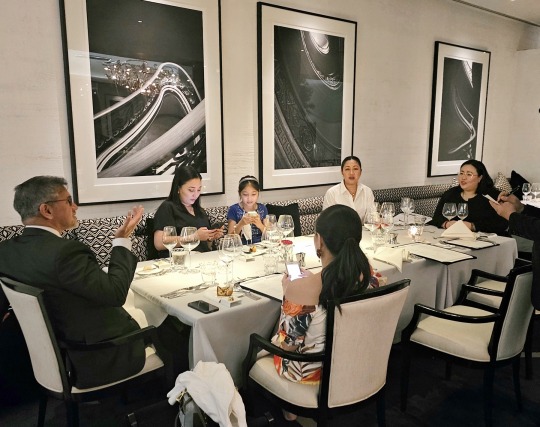
Our lovely dinner that evening was hosted by Mariano Garchitorena, The Peninsula Manila’s Director of Public Relations. We were also having dinner together with the Koppes who are always fun and entertaining companions.
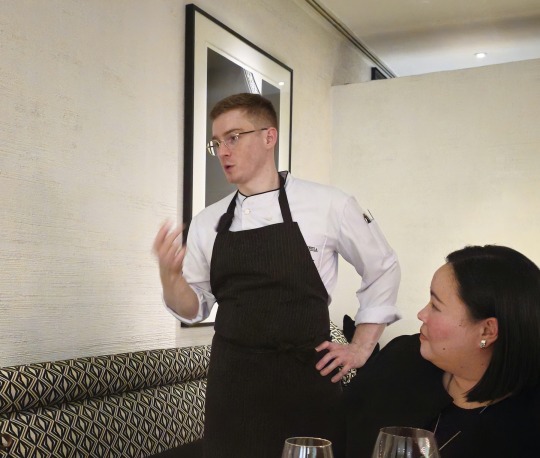
The new chef at the helm of Old Manila is the talented French Chef de Cuisine Gaël Kubler who brings a new culinary flair to this iconic restaurant. He explained how he is learning more about the Filipino palate during his three months in the country and he is continuing to develop new dishes and ideas for Old Manila.
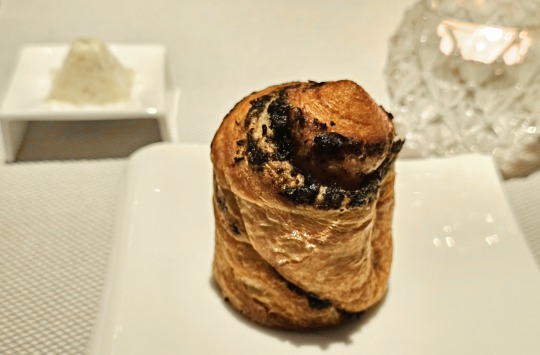
For tonight, Chef Gaël will be bringing out some of the most popular items on Old Manila’s new menu. We started with a choice of breads accompanied by rum raisin butter. This pair alone gave us a tasty preview of what else is to come.
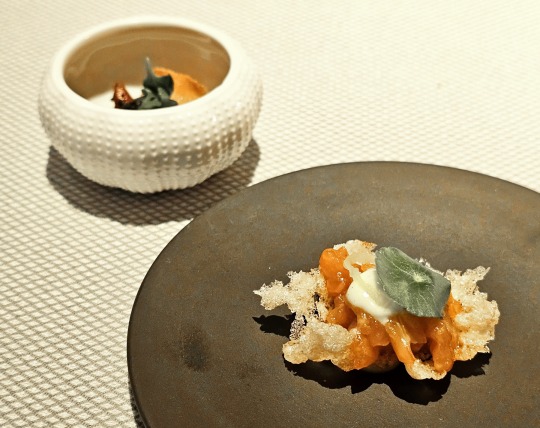
We were also given an amuse bouche consisting of Tartare and Eggplant Caviar. The tartare was a delightful mix of flavors while the eggplant caviar was a surprise with its creamy texture.
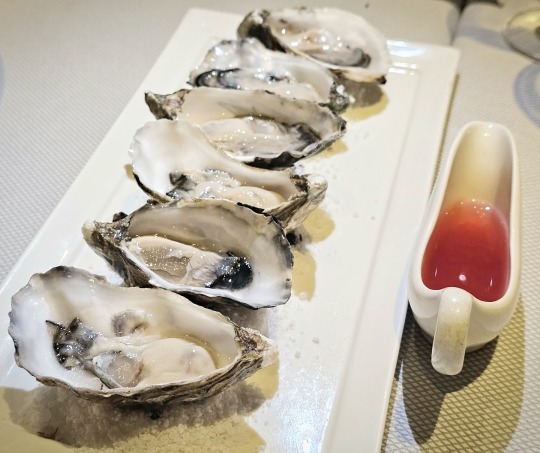
Here are a few of the special appetizers on the menu. The Fresh Irish Gallagher Oysters (P1,690) look like they were just plucked from the ocean. These high-quality imported oysters are served with red wine and shallot mignonette.

The colorful Ahi Tuna Carpaccio (P1,490) comes with raw tuna prepared with calamansi gel, pickled mango, ginger oil and coconut dressing. This is a good starter that can be shared with the group.
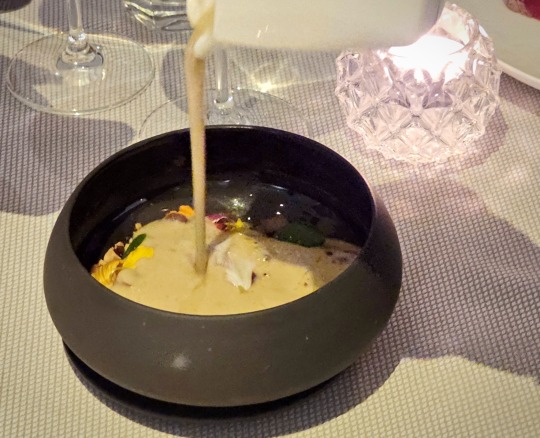
What really blew me and everyone away was the Jerusalem Artichoke Veloute (P1,290). This is honestly one of the best soups I have ever tasted. The creamy and very fragrant broth is made with guanciale, hazelnut, and truffle. You can taste the truffle flavors balanced with the creamy ingredients which make it such a heavenly bowl.
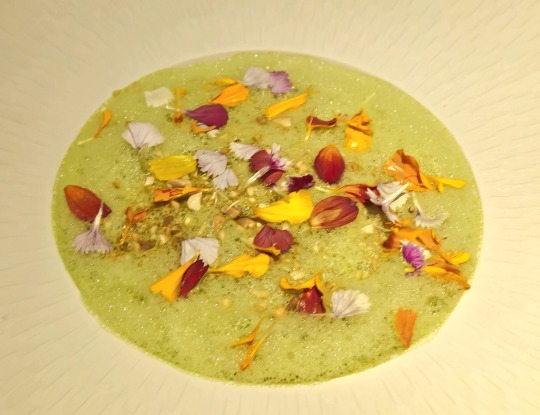
For the main courses, you can choose something light like the Green Asparagus Risotto (P1,790). This is made with amaretto, roasted pistachio, pancetta, and Parmesan.
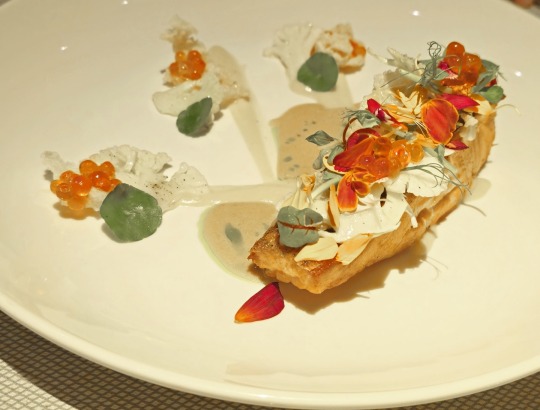
Another optoin is the Tasmanian Salmon (P2,690) with cauliflower puree, herb oil, and iodized sauce. This is what Chiara ordered, something simple yet elegant that even kids will enjoy.
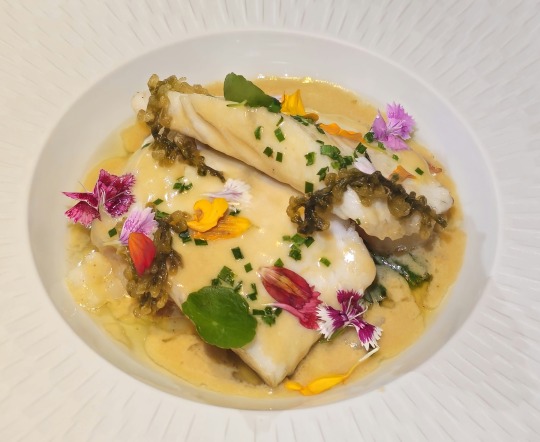
There's also the Atlantic Turbot (P2,890) with its delightful combination of prawns, oyster mushroom, bok choi, potato, and ginger beurre blanc,
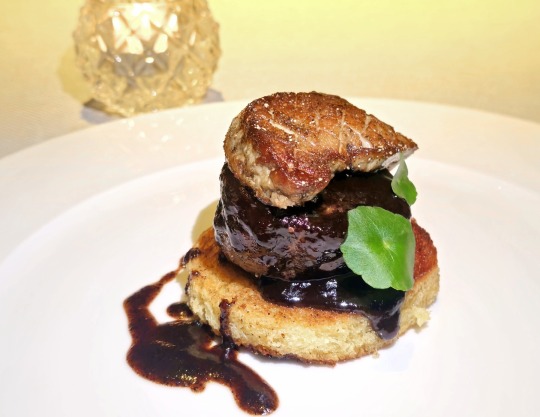
I ordered the Tournedos Rossini (P3,190) simply because I love anything with steak and foie gras. This has a thick cut of black opal wagyu topped with a luscious duck foie gras on a brioche bun and served with truffle mash on the side. The combination was just perfect with the tender wagyu giving way to the delicate but generous slice of foie gras.
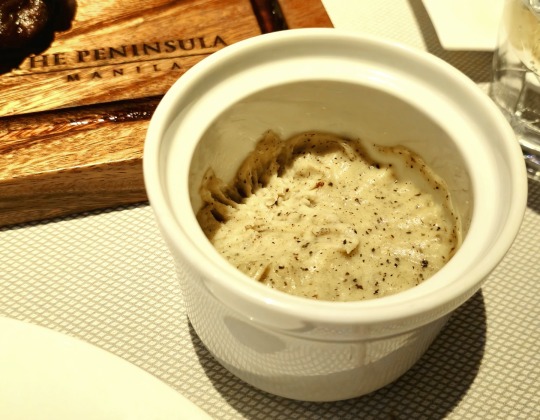

Look at how big these Jumbo Tiger Prawns (P2,890) are! These are three huge pieces of juicy tiger prawns cooked fresh off the grill. You can have a full dinner with just these prawns.

But the highlight of our dinner at Old Manila is definitely the Jack's Creek Wagyu Tomahawk MB5 Steak (P11,990). This is a 1.2 kilogram wagyu steak cooked with its bone gloriously hanging by the side.

The steak was cooked perfectly medium, giving it a juicy and tender texture. The flavors of the beef were highlighted with every bite. All items from the grill come with your choice of sauce including bearnaise, red wine, green peppercorn, and ginger beurre blanc.
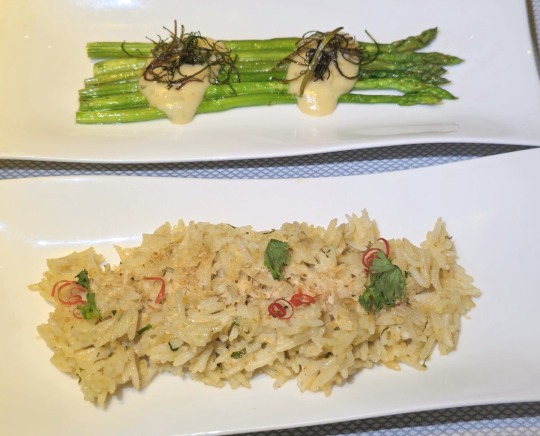
It also comes with two side dishes like the Grilled Green Asparagus with dill dijonnaise and fried leeks. You can also choose the Coconut Fried Rice with green curry, calamansi, and red chili.

The Dessert selection at Old Manila (P690 each) is also not to be missed. The Banana and Toffee comes with tuile, crémeux, and rum raisin ice cream.

There’s also the Pear and Hazelnut with spiced moscato, sponge, and salted caramel ice cream. All the dessert items look quite elegant with their presentation.
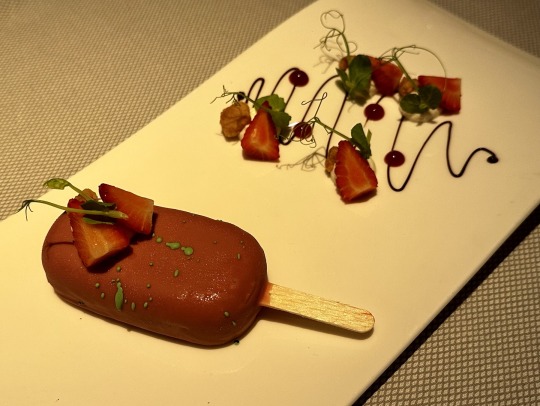
The Lime, Basil, and Strawberry come with sorbet, berries gel, and lemon crumble. Everyone’s favorite dessert turned out to be the Chocolate and Raspberry with fondant, ganache, and coulis. It was shaped and presented like a tree with soil and branches which makes it quite a popular item for photos.

We would like to thank Mr. Garch and Ms. Grace of The Peninsula Manila for hosting our fantastic dinner at Old Manila. We’re so happy that this dining institution in Makati is finally open once again to give the well-discerned foodies of Manila another venue to explore these culinary offerings. See you at The Pen soon!

Old Manila
Ground Level, The Peninsula Manila, Ayala Avenue corner and Makati Avenue, Makati City
8887-2888
www.peninsula.com/manila
www.facebook.com/ThePeninsulaManila
0 notes
Text
Italian Dish Spotlights Pt. 1
Carbonara
The carbonara, a roman pasta dish, typically consists of a tube-type or spaghetti pasta (I prefer rigatoni) which is tossed with a mixture of egg yolks, pecorino (and/or parmigiano), black pepper, and pasta water. The dish is topped with a hefty handful of guanciale (a cured pork jowl similar to pancetta) and more black pepper. My favorite pasta by far and a unanimously loved white pasta. Man this is delicious… I am honestly salivating just thinking about it. The dish is creamy from the emulsifying yolk sauce, salty and meaty and fatty from the guanciale, and nutty-spicy from the generous black pepper. This was actually my favorite pasta long before I came to Italy, but the best carbonara I ate by far were those in Italy. I look forward to making this according to my host mothers recipe.
Pizza
I mean, while I’m here… I will likely make a separate post just for pizza, but I’ll be brief here. There are many different variations of the pizza that come from all over Italy. Roman style ‘pizza al taglio’ is a large, rectangular pizza with a thick, almost focaccia-ey crust and all types of toppings. In these restaurants, which are frequented by the youth on nights out, all you need to do is indicate how much of a certain flavor of pizza you’d like and they’ll heat it up and you’ll be on your way. There are micro-categories of pizza from Bari, Sicily, etc. Most notable is the Napoletana style of pizza, of course. The soft, bubbly, and lovingly burnt crust that cradles delicious and fresh ingredients with emphases on good quality tomatoes is unmissable.
Pasticciotti
A typical pastry from my host region. They are typically an oval of thick short-crust that is often filled with plain custard but can be found with ricotta, nutella, various fruit, pistachio, and mixed fillings. Quite good, however, Its old-fashionedness does in fact display how behind Italy stands on the sweets and pastries train.
Cafe Leccese
A delicious coffee drink also native to my Lecce province (but said to have navigated there from the Iberian peninsula), and one of the only times Europeans willingly choose to utilize ice. Usually a double shot of espresso over ice with a heaping tablespoon of ‘latte di mandorla’ which, although it literally translates to almond milk, is a very thick and very almond almond syrup with a touch of lemon that is made in Puglia. It’s recipe is deceptively simple, and the drink has a complex, sweet, and refreshing flavor that was perfect for the bitingly hot mornings on which I simply could not drink a hot cappuccino.




1 note
·
View note
Note
how many female uncles do you have
- not eli
Carbonara (Italian: [karboˈnaːra]) is an Italian pasta dish from Rome[1][2] made with eggs, hard cheese, cured pork, and black pepper. The dish arrived at its modern form, with its current name, in the middle of the 20th century. The cheese is usually Pecorino Romano, Parmigiano-Reggiano, or a combination of the two.[1][4] Spaghetti is the most common pasta, but fettuccine, rigatoni, linguine, or bucatini are also used. Normally guanciale or pancetta are used for the meat component,[1][2] but lardons of smoked bacon are a common substitute outside Italy. As with many recipes, the origins of the dish and its name are obscure;[5] however, most sources trace its origin to the region of Lazio. The dish forms part of a family of dishes involving pasta with bacon, cheese, and pepper, one of which is pasta alla gricia. Indeed, it is very similar to pasta cacio e uova, a dish dressed with melted lard and a mixture of eggs and cheese, which is documented as long ago as 1839, and, according to some researchers and older Italians, may have been the pre-Second World War name of carbonara. There are many theories for the origin of the name carbonara, which is likely more recent than the dish itself.[4] Since the name is derived from carbonaro (the Italian word for 'charcoal burner'), some believe the dish was first made as a hearty meal for Italian charcoal workers.[1] In parts of the United States, this etymology gave rise to the term "coal miner's spaghetti". It has even been suggested that it was created as a tribute to the Carbonari ('charcoalmen') secret society prominent in the early, repressed stages of Italian unification in the early 19th century.[6] It seems more likely that it is an "urban dish" from Rome,[7] perhaps popularized by the restaurant La Carbonara in Rome.
The names pasta alla carbonara and spaghetti alla carbonara are unrecorded before the Second World War; notably, it is absent from Ada Boni's 1930 La Cucina Romana ("Roman cuisine").[4] The carbonara name is first attested in 1950, when it was described in the Italian newspaper La Stampa as a dish sought by American officers after the Allied liberation of Rome in 1944.[10] It was described as a "Roman dish" at a time when many Italians were eating eggs and bacon supplied by troops from the United States.[8] In 1954, it was included in Elizabeth David's Italian Food, an English-language cookbook published in Great Britain.[11]
0 notes
Text
Tasty Pasta & Sauces-Italian Cuisine
Italian pasta sauces you should know and taste!
Italian cuisine has a great variety of tasty pasta and sauces. When it comes to pasta, size and shape matter. It includes noodles in various lengths, widths and shapes. So, most pastas may be distinguished by the shapes for which they are name, for instance, penne, maccheroni, spaghetti, linguine, fusilli, lasagne, and many more varieties that are filled with other ingredients like ravioli and tortellini.

Thus, there are hundreds of different shapes of pasta with at least locally recognized names and as you might have noticed, however we really don’t get bored of talking about them. In addition, every kind of pasta brings a sauce together in order to elevate just about any meal.
The secret’s in the Sauce
Even the greatest shape of pasta is nothing without its accompanying sauce. Thus, making one powerhouse sauce can guide a full week of flavorful meals. Most of these dishes and sauces consists of typically Mediterranean ingredients and some of these have been passed down through generations of Italians while others are Italian-American classics and have earned their rightful place in the sauced pasta canon. Next, these tasty sauces are just few examples of an excellent instant dressing for any pasta dish:

Classic Tomato Sauce
A true classic of Italian cuisine, it is perfect for pasta, meatballs, pizzas and more. The simplest tomato sauce consists just of chopped tomatoes cooked down (possibly with olive oil) and simmered until it loses its raw flavor. Of course, it may be seasoned with salt, fresh garlic, basil, oregano, paprika and other herbs or spices.
Carbonara
Pasta with carbonara sauce is a fundamentally simple and easy dish, made by coating pasta in a rich, creamy sauce of eggs, hard cheese, cured pork, and black pepper. The cheese is usually Pecorino Romano, Parmesan, or a combination of the two. The challenge is in combining the right ingredients for a sauce with a perfectly silky texture, and not accidentally scrambling those eggs in the process.
Spaghetti is the most common pasta, but fettuccine, rigatoni, linguine, or bucatini are also used. Normally guanciale or pancetta are used for the meat component, but lardons of smoked bacon are a common substitute outside Italy.
Ragù alla Bolognese
Possibly the best known Italian pasta sauce. It is a meat-based sauce in Italian cuisine. The base of this classic consists of beef, pork or a combination of both, as well as ripe, fresh tomatoes or tomato purée, red bologna or very dry white wine, nutmeg, salt, and pepper. Common additions may also include Italian pancetta and milk or cream. It’s usually served with gnocchi or larger, flatter pasta like tagliatelle, pappardelle or fettuccine.
Pesto alla Genovese
Classic Italian pesto combines olive oil, basil, pine nuts, parmesan cheese, and hails from Genoa. It’s a rich green color, thanks to lots of basil, with a powerful and tantalizing aroma. In addition, Its name stems from the word pestare, meaning to pound or crush, referring to the original method of making the sauce with a mortar and pestle. Pesto is commonly used on pasta, traditionally with mandilli de sæa, that is, (“silk handkerchiefs” in the Genoese dialect), trofie or trenette.
Puttanesca
We all know the meaning of the name – “Prostitute’s Sauce” – but how exactly the name came to be is less certain. Fans of salty flavours will love the combination of olives, anchovies and capers that characterize this quick and flavorful sauce. Traditionally, the sauce is served with spaghetti, penne, bucatini, linguine, and vermicelli.

Aglio e Olio
Aglio e olio merely translates to garlic and oil—also known as the most basic pasta sauce. The main ingredients that go into an aglio e olio sauce are olive oil, garlic, peperoncino (or chilli flakes), parsley and some pasta water that turns everything into a smooth sauce. And of course, a generous helping of parmesan on top helps but is completely optional. At heart, however, it is the base of all Italian pasta sauces, which is what makes it so great.
Cacio e Pepe
An incredibly simple pasta dish out there – just cheese, butter and black pepper – but one with incredible results. The surprising creaminess comes from adding a little water used to cook the spaghetti, with the starch combining with the cheese to make creamy magic. Rough-surfaced pasta makes the sauce adhere well.

Marinara
Marinara is vibrant red and fairly chunky tomato sauce that is essential for an Italian food repertoire. It consists of tomatoes, garlic, herbs, and onions. In addition, it can include capers, olives, spices, and a dash of wine as possible ingredients in its many variations.Consequently, It’s quick to prepare and has a bright, fresh flavour that lends itself to many different pasta varieties, gnocchi, vermicelli, and baked ziti.
In sum, you can experiment with matching different tasty sauces with different types of pasta to ensure an exquisite combination of flavors. Italian Villa offers the most delicious and traditional saucy italian pasta dishes. Our sauces are made with the highest quality ingredients, all fresh and perfectly combined to create the authentic flavor of italian sauces. Taste your preferred!
———————————————–
ABOUT ITALIAN VILLA RESTAURANT:
We are one of the premier Italian Restaurants in Allen, TX, offering home-made traditional Italian cuisine. Come visit us today at: 121-B N. Greenville Allen, TX 75002, Phone: 972-390-2189
The post Tasty Pasta & Sauces-Italian Cuisine appeared first on Italian Villa Allen.
from Italian Villa Allen https://ift.tt/2GCoiPL
0 notes
Text
10 Traditional Italian Sauces

Feelin’ saucy? Good. Today we’re breaking down some traditional Italian sauces. The good ones of course. Ya know, ones you’ll find all over the Mortadella Head menu… We’ll start with the basics, then work our way down to the more robust of sauces. (will need help ordering these)
Marinara - We’ve said it before, and we’ll say it again: stick to the basics. Marinara is a quick sauce, seasoned only with garlic, crushed red pepper, and basil. It’s best when made with San Marzano tomatoes LINK, -- one of the best varieties for tomato sauces. Marinara can be left chunky so as to enjoy the taste of fresh tomatoes.
Tomato - Tomato sauce, on the other hand, is a more complex affair. Pureed tomatoes are seasoned with onion, carrot, celery and a bay leaf and is left to simmer until thickened. You’ll get a sweet, rich sauce that’s just a bit different than marinara.
Bolognese - Sometimes called “gravy”, this rich meat sauce is extremely versatile and full of flavor. But it’s so much more than just a meat sauce. A traditional bolognese must contain onions, celery, carrots, pancetta, ground beef, tomatoes, and white wine. Once you’ve had a true bolognese it will be one of your go-to recipes. Make enough to serve a crowd and never, ever forget plenty of freshly-grated Parmesan Reggiano.
Pesto - While there are plenty of variations all over the internet, we prefer a classic pesto made with fresh basil, garlic, pine nuts, extra virgin olive oil, parmesan reggiano and sea salt. It’s a great sauce for pasta, but also a number of kitchen creations. LINK
Puttanesca - Originally thought to be “the poor man’s meal”, this simple dish makes use of ingredients that were inexpensive and abundant in Italy back in the day. To make it a puttanesca sauce, you’ll need these pantry essentials: olives, anchovies, garlic, tomatoes and capers. Don’t fear those anchovies; use them sparingly for just a hint of flavor.
Carbonara - Would you believe you can create a creamy, luscious sauce with just four ingredients? It’s true. The real Italian version uses only guanciale, eggs, pecorino cheese, and lots of black pepper. You can substitute guanciale for pancetta, but other than that, no changes to this classic!
Vodka sauce - Red sauce, white sauce, pink sauce? Yes, pink sauce. There are many versions of vodka sauce, but the base is tomatoes, vodka, and heavy cream. Some recipes include butter, parmesan cheese, and fresh herbs. Don’t be concerned about the taste of vodka; it’s only there to enhance the flavors. And hello, it’s called vodka sauce. You have to include it!
Amatriciana - In its purest form, amatriciana includes four main ingredients tomatoes, guanciale, pecorino cheese, and hot peppers. It’s a simple, yet rustic sauce that you’ll be craving often. Pro tip: Garlic is not used in this sauce. It’s one of the few Italian recipes without it!
Arrabiata - Literally translating to “angry tomato”, an arrabiata sauce is -- you guessed it -- spicy. THanks to the addition of lots of garlic and red pepper flakes, this one packs a lot of heat. Cook it low and slow and add as much pepper as you like. Have a glass of water nearby just in case.
Bechamel - It’s origins may be somewhat of a mystery, but the traditional version is created by whisking hot milk into a roux of flour and butter. If any of the sauces on this list require some patience, it’s this one. But we promise it’s worth the wait.
Browse through the https://mortadellahead.com/ and you will see what you have been missing out on for all these years. Delivering the best Italian food online!
#sauces#Italian food online#Italian breakfast online#best Italian breakfast online#order Italian breakfast online#buy Italian pizza online
0 notes
Text
Connected food

The first time we brought Spawn to Edinburgh to callously abandon her tearful little face in a soulless new-build apartment block, we were directed by a recommendation in our hotel to a nearby ‘Italian’ restaurant. We ate there, possibly twice, and we ate there again when we came to visit, when we came to collect her, when we brought her back, and so on. She’s only into the start of her third year as I write this, so we’ve been going there for a little over two years, but they know us now. We turned up with a whole crowd of friends during our visit to the Fringe this summer, and we went again when we installed Spawn in her digs.
Ristorante Isola is a very rare beast in affordable British dining. ‘Italian’ food is everywhere – on our way home from Edinburgh we were diverted through the unfeasibly picturesque Lincolnshire town of Stamford, and the place was infested with generic Italian dining establishments, chain and local. There is almost nowhere that it isn’t easy to find a place that offers pizza, some form of pasta, starters that resemble antipasti, draft Peroni and tiramisu. Some of these places are good or even excellent, but what I’ve rarely come across anywhere else in Britain is an Italian regional cuisine. Isola serves Sardinian food, and while I can’t comment directly on its authenticity, the menu has the kind of coherence and consistency that my limited experience leads me to associate with geographically specific food cultures.
Sardinian food, as presented by Isola, is not totally different to other Italian food I’ve eaten, but it has its own character. The menu is full of exciting marine produce (their seafood risotto is a reliably wonderful plateful), and beautifully-cooked meat, as well as a variety of pastas and sauces – they also serve pizza, but none of us has ever tried it. Octopus and pork are characteristically Sardinian ingredients, I understand, but the flavour which seems to be truly characteristic of the island’s cuisine is that of myrtle – a plant which I didn’t even realise could be eaten, although it turns out that it’s in mortadella, and is also widely used in Corsica.
On our most recent Spawn-depositing trip to Edinburgh I began with stuffed artichokes, which had been filled with mashed potato, and topped with melted cheese, possibly some kind of young pecorino (although I’m almost certainly wrong). A dish like this raises a phenomenon that I’ve observed as I’ve learned more about Italian cooking, one which Rachel Roddy also notes in her book Five Quarters. The ‘Mediterranean diet’ which has been widely promoted as a healthy one, and which supposedly consists largely of fish, vegetables and olive oil, seems in practice to cleave pretty closely to the hearty Northern European comfort-food formula of carbs, meat and dairy. I mean, yes, people in Southern Europe certainly appreciate and understand their seafood, and the vegetable dishes I’ve tried in Spain and more recently in Sicily have been wonderful, but the standard plate of food is still a pile of gorgeous warming stodge: there are a lot of parallels between traditional working-class cooking in Italy and England. Mashed potato with melted cheese is a winner every time, but combined with the delicately aromatic flavour and firm but yielding flesh of a well-prepared artichoke, it is sex on a plate. I swapped one for one of Spouse’s scallops, delightfully firm and sweet, with just the right amount of salt and umami from the accompanying pancetta.
I followed those four parcels of gustatory paradise with ravioli filled with taleggio, pear, and some kind of nut, probably walnut. I’d be more precise with a bit of retrospective research, but that part of Isola’s menu isn’t quite legible on their website. The pasta was perfect; although every self-respecting domestic cook in Italy cooks beautiful egg pasta, it’s still amazing how dense and dry it can be in an English restaurant. Furthermore, the contents of the pasta were not only perfectly prepared, they offered a completely congruent and mouth-exciting flavour combination. Taleggio is a rinsed-rind cow’s milk cheese, and it proves to pair as well with pear as blue cheeses do – without the acid ammoniac tang of a blue the pear seems rounder and sweeter, but the flavour of the cheese itself also came through very distinctly. A little musty crunch of nut perfectly complemented the two dominant ingredients, harmonising with the truffle oil in the creamy sauce, and I was a very happy boy.
The food at Isola is always good restaurant cooking, the kind of stuff you have to go out for, cooked with the kind of skill that’s rarely found in a domestic kitchen, but it has a homely element as well. It’s clearly cooked with love, and although it is creative it isn’t experimental: it doesn’t make the diner work for the experience. Every plateful has a familiarity to it, and lets you settle into it like a well-used armchair. This was particularly the case with Spawn’s primo, a plateful of spaghetti carbonara which she said (to my great delight) was almost indistinguishable from the carbonara I cook at home, although I use pancetta (belly bacon) rather than the more authentic, but much fattier guanciale (cheek). They must have access to some good eggs to compete with the ones laid by our hens.
We have always been made to feel welcome in Ristorante Isola, where service is delivered with friendliness and professional efficiency. There is a dignity to the profession of waiter in some European countries that it is hard for English front-of-house staff to emulate: you know when you order here that you are speaking to someone who knows the menu, who knows food, who takes pride in the work of communicating the subtleties of the menu to the guest and the needs of the diner to the kitchen. At the same time there is no artificial formality, and by the time you’ve been often enough for your face to be familiar, you will be in no doubt that your custom is valued. We’ve had some good conversations here, and we are beginning to feel a strong connection to Sardinia. When we visit, and thanks almost entirely to the experience of eating at Isola we will definitely be visiting, we will already know something about the island’s food, and we’ll be as keen to savour its virtues in the wild as we were to eat arancine in Sicily.
We finished our meal with (for Spouse and myself) a caffè coretto made with grappa: our waiter confessed that her hand had slipped, and they were very strong, but entertainingly so. I had their excellent saffron semifreddo drizzled with honey, which is served much less frozen than in most UK restaurants, and they supplied us with a complimentary round of Mirto liqueur, made from the ubiquitous myrtle. It tastes a little like medicine, but it feels like exactly the right thing to have in your mouth after a meal at Isola. ‘Isola’ means ‘island’, but it does not mean ‘isolated’: it’s rare to find a place to eat out where I feel such a strong sense of connection as here, to the food and the people, and where I feel completely safe in the kitchen’s hands – I often just jab my finger at the menu and order the first thing I encounter. We were informed that they have a ten-year lease on the premises, so we probably have another seven years or so to enjoy their food: we will take every opportunity.
0 notes
Text
The Best Spaghetti Carbonara Recipe
Spaghetti Carbonara is an Italian pasta dish with creamy egg, diced bacon, grated cheese, and copious amounts of black pepper–a Roman dish reminiscent of an American breakfast.
Spaghetti Carbonara
Carbonara is typically made with a raw egg that cooks when it hits the hot pasta, which often makes it pasty. My version is topped with a poached egg so the yolk is already warm when it tops the spaghetti. This creates a velvety sauce that blends easier — giving it richness without binding. Rather than using Pancetta here, I used leaner center-cut bacon and also added some greens to the mix – it’s beyond delicious!
I recently went on the trip of a lifetime to Rome and the Amalfi Coast near Naples, Italy—the center of authentic Italian pasta manufacturing. It was an incredible experience and gave me a whole new appreciation for Italian pasta and their cuisine. While there we toured the oldest pasta factory in Italy, located in southern city of Gragnano in the Campania region of Italy. It’s located between the coast and the mountains—the ideal location for making and drying pasta, which also happens to be where they manufacture Dellalo Pasta. The experience was as dreamy as it gets, sharing great food with amazing friends while enjoying the stunning coastal views. On the tour, we visited the mill where Dellalo’s wheat is ground (grain has been milled since the 1200’s) and even took an Italian cooking class where we learned how to cook three authentic pasta dishes all using ingredients from Dellalo. To be honest, I never wanted the trip to end.
If you’ve been following me for a while, you know how much I love DeLallo Foods, a brand I’ve worked with for years. Why do I love Dellalo so much? For starters, they import only the best ingredients direct from Italy to the U.S. Here’s a few more reasons why DeLallo pasta is better than other brands you may find in the grocery store:
DeLallo Pasta vs Grocery Store Pasta:
Made in Italy. DeLallo Pasta comes from the town where pasta was born, a region near Naples, at the beginning of the Amalfi Coast.
Made with just 2 ingredients – wheat and water. The wheat is a locally milled, exclusive blend of the highest quality durum wheat with a high gluten content. It’s mixed with water from the local aquifer in the Lattari Mountains. The pure water contains less calcium so it makes a more supple pasta.
Dried slowly at low temperatures to preserve pasta’s color, texture and flavor throughout the cooking process. DeLallo pasta has a natural drying time of 18 hours compared to some other commercial brands who bake their pasta for just four hours, and use cheaper, lower protein flour.
Extruded with bronze dies. Delallo pasta has over 200 bronze dies in different shapes to create a rougher surface that absorbs and captures the sauces. Other manufactures use Teflon and plastic dies to mass produce pasta faster, but definitely not better.
Cooks perfectly al dente. DeLallo’s pasta is golden in color and cooks up for that signature al dente texture: a tender but firm bite with a fleck of white at its center—what we call the pasta’s soul.
DeLallo pasta is is made following the strict guidelines of Pasta di Gragnano PGI and is produced in a legally defined territory defined by the king of Napoli two centuries ago. Only pasta in this area can note this distinction, which protects the quality of the product.
What is Spaghetti Carbonara?
Spaghetti Carbonara is an Italian pasta dish made from Rome made with egg, a combination of Pecorino Romano and Parmigiano-Reggiano, guanciale or bacon, and black pepper. Sounds complicated, but it’s actually quite simple to make. Although it’s creamy, it’s actually made without cream.
Traditional spaghetti alla carbonara, the egg yolk is added raw to the hot pasta and starts to cook on contact. The downside to this, unless you’re eating it immediately, the carbonara becomes dried out if you don’t eat it immediately. With the method of poaching the egg instead, is inspired by Crispo, my favorite Italian restaurant in NYC there’s no need to worry if the egg is still raw and the whole bowl of pasta doesn’t get all clumped together when you are ready to eat it.
How To Make Spaghetti Carbonara
(embed)https://www.youtube.com/watch?v=jUKhmqCa5l0(/embed)
More Pasta Recipes You Will Love
Spaghetti Carbonara
Prep Time: 10 mins
Cook Time: 20 mins
Total Time: 30 mins
Spaghetti Carbonara is an Italian pasta dish with creamy egg, diced bacon, grated cheese, and copious amounts of black pepper–a Roman dish reminiscent of an American breakfast.
10 ounces dried Delallo spaghetti, or gluten-free spaghetti
6 slices center cut bacon, cut into 1/2-inch dices
3/4 cup low-sodium chicken broth
1 1/2 cups baby arugula or frisée lettuce , chopped
3 tbsp Italian parsley, chopped
kosher salt and ground black pepper
1/4 cup grated Parmigiano Reggiano cheese
3 tablespoons grated Pecorino Romano, preferably Locatelli
4 extra large eggs
Poaching liquid:
4 cups cold water
6 tbsp white vinegar
1/4 tsp kosher salt
Bring a large pot of generously salted water to a boil.
In a deep skillet or medium pot, egg-poaching liquid to a boil over high heat, then leave on low heat.
Heat a large (12-inch) skillet over medium-high heat, cook bacon until fat renders and meat is slightly crisp, about 10 minutes. Set aside with a slotted spoon and transfer to a plate, leaving the fat in the skillet.
At the same time, add the pasta to the salted water, and add the broth to the bacon fat and simmer the broth to reduce by 1/3, about 8 to 10 minutes.
Cook the pasta until al dente, under-cooking by 2 minutes, about 8 to 10 minutes. Drain pasta but do not rinse.
To the broth add the arugula, parsley and 1/4 teaspoon salt and black pepper.
Add drained pasta, raise heat to high, and toss to coat with sauce.
Finish cooking the pasta in the broth for 2 minutes, then remove from heat, stir in cheese, and toss. The spaghetti will soak up any liquid.
Working one at a time, carefully crack each egg into a small bowl and very gently slide into barely boiling poaching liquid. Cook until whites set but yolks are still runny, about 2 to 3 minutes. Using a slotted spoon, lift each egg out of the water.
Evenly divide pasta between 4 warm bowls. Place each egg atop each bowl of pasta. Top generously with black pepper.
Serve immediately, mixing up the pasta to spread the egg and yolk throughout the bowl.
(embed)https://www.youtube.com/watch?v=jUKhmqCa5l0(/embed)
Serving: 1generous cup pasta with 1 egg, Calories: 422kcal, Carbohydrates: 52g, Protein: 23g, Fat: 12g, Saturated Fat: 5g, Cholesterol: 227mg, Sodium: 546mg, Fiber: 3g, Sugar: 3g
Blue Smart Points: 10
Green Smart Points: 12
Purple Smart Points: 10
Points +: 11
Keywords: How To Make Spaghetti Carbonara, pasta carbonara, spaghetti carbonara, spaghetti carbonara without cream
Sponsored by DeLallo Foods. Thanks for supporting the brands I love that make Skinnytaste possible.
posted October 9, 2019 by Gina
The post The Best Spaghetti Carbonara Recipe appeared first on All Repices.
from WordPress https://ift.tt/2YTFx3S via IFTTT
0 notes
Text
Frico | Memorie di Angelina
New Post has been published on http://cucinacarmela.com/frico-memorie-di-angelina/
Frico | Memorie di Angelina
amzn_assoc_placement = "adunit0"; amzn_assoc_tracking_id = "carmela-20"; amzn_assoc_ad_mode = "search"; amzn_assoc_ad_type = "smart"; amzn_assoc_marketplace = "amazon"; amzn_assoc_region = "US"; amzn_assoc_title = "Shop Related Products"; amzn_assoc_default_search_phrase = "cooking"; amzn_assoc_default_category = "Kitchen"; amzn_assoc_linkid = "51fe4d035c7af8dc5928e6f5e5b79c4e"; amzn_assoc_default_browse_node = "284507"; amzn_assoc_rows = "4"; amzn_assoc_design = "text_links";
Spring is finally here you say? Well, not around these parts. It’s cold and wet, and there’s snow on the ground—comfort food weather. And is there anything more comforting than melted cheese?
Today’s recipe, one of two dishes called frico, is something like a potato pancake, only you pile on lots of cheese, specifically a mild Alpine cheese called Montasio (see Notes). The cheese melts into the potato and forms a delicious round of goodness, warm and creamy on the inside, golden and crispy on the outside. Washed down with a glass of red wine, frico can really help cheer the spirits on a gloomy evening. Almost makes you wish winter would stick around for a while longer…
Personally I would serve frico on its own as either a first course or a vegetarian second, although I understand it’s usually served with polenta as a kind of piatto unico, which sounds really filling…
Ingredients
Serves 4-6
1 small onion, peeled and thinly sliced
700g (1-1/2 lbs) potatoes, peeled and diced
350g (3/4 lb) Montasio cheese, coarsely shredded or cut into small dice
Salt and pepper
Olive oil, lard, or lardo minced into a paste
75g (2-1/2 oz) pancetta, guanciale or speck, cut into small dice (optional)
Directions
Sauté the onion gently in the olive oil or lard or minced lardo in a skillet (nonstick is best) until soft and translucent, along with the pancetta, guanciale or speck if using.
Add the potatoes and mix together with the onions. Season generously with salt and pepper, then add a glassful of water and cover. Let the potatoes simmer until soft, adding more water if necessary. Uncover and let any remaining liquid evaporate, smashing the potato with a wooden spoon into a very rough purée. (Leave some of the potato dice whole for a more interesting texture.)
Add the cheese and fold it well into the potato and onion. Stir from time to time over gentle heat until the cheese melts completely. Continue simmering for another 5-10 minutes, until the mixture has thickened enough that it forms a solid mass.
Now flatten out the mixture and turn the heat up. Let the mixture form a nice brown crust on the bottom, then flip it over and let it brown on the other side, as if you were making a frittata, about 3-5 minutes per side. (Repeat if need be to get a nice crust.)
Serve immediately, while the cheese is still warm and creamy.
Notes on Frico
The star of this dish is Montasio cheese. This cow’s milk cheese has been around since the 13th century, traditionally made by monks living in the Moggio abbey, located in the Carnic Alps staddle Friuli and neighboring Austria. The cheese takes its name from the nearby mountain named the Jôf di Montasio. A young Montasio is aged 2 to 5 months, producing a mild tasting semi-hard cheese. An older Montasio is aged 12 months, producing a hard grating cheese with a much sharper flavor. It’s the young type you will want for this dish, although some recipes call for a bit of the older type, too, for flavor.
Montasio can be hard to find in stores, although you can order it online. Otherwise, you can substitute another mildly flavored semi-hard Alpine cheese like Emmenthal or gruyère or a young Asiago, or perhaps a Fontal. Any meltable cheese that you like, really, will produce something delicious. After all, with sautéed onions and potatoes and melted cheese, how can you go wrong?
Variations
There are any number of ways to make frico. There are different ways to treat the potatoes. They can be sliced, cut into chunks or grated rather than diced, each producing a different texture in the final product. In some recipes, you boil or steam the potatoes separately, then add them to the sautéed onion, let them sauté gently for a few minutes, then add the cheese and proceed from there. Some recipes call for a two pot method: You cook the onion-potato-cheese mixture over low heat in a saucepan over low heat, and then brown it in oil over higher heat in a separate skillet.
The cheese content varies widely from recipe to recipe. Some call for a very cheesy frico, with a 1:1 ratio of potato to cheese, double the 2:1 ratio shown here. And if you’re a real cheese maven, you could try this potato-less version of frico from Eleanora Baldwin.
NB: There is another, quite distinct dish also called frico. It is made entirely from Montasio, usually the hard, aged variety, but sometimes using a mix of aged and semi-aged cheeses. You fry the cubed or grated cheese in a non-stick skillet over moderate heat until brown on the bottom, then flip it over and brown it on the other side until you have a thin, round crisp. If laid over a small bowl to cool, the crisps form a basket. Otherwise, you can lay them on paper towels to absorb the excess grease and serve them as an antipasto or snack.
Ingredients
1 small onion, peeled and thinly sliced
700g (1-1/2 lbs) potatoes, peeled and diced
350g (3/4 lb) Montasio cheese, coarsely grated or cut into small dice
Salt and pepper
Olive oil, lard, or lardo minced into a paste
75g (2-1/2 oz) pancetta or Speck (optional)
Directions
Sauté the onion gently in the olive oil or lard in a skillet (nonstick is best) until soft and translucent, along with the pancetta or speck if using.
Add the potatoes and mix together with the onions. Season generously with salt and pepper, then add a glassful of water and cover. Let the potatoes simmer until soft, adding more water if necessary. Uncover and let any remaining liquid evaporate, smashing the potato with a wooden spoon into a very rough purée, leaving some of the potato dice whole.
Add the cheese and fold it well into the potato and onion. Stir from time to time over gentle heat until the cheese melts completely. Continue simmering for another 5-10 minutes, until the mixture has thickened enough that it forms a solid mass.
Now flatten out the mixture and turn the heat up. Let the mixture form a nice brown crust on the bottom, then flip it over and let it brown on the other side, as if you were making a frittata, about 3-5 minutes per side, (Repeat if need be to get a nice crust.)
Serve immediately, while the cheese is still warm and creamy.
0.1
http://memoriediangelina.com/2018/03/23/frico/
(c) Frank Fariello
SaveSave
SaveSave
SaveSave
SaveSave
SaveSave
SaveSave
SaveSave
Related
!function(f,b,e,v,n,t,s)if(f.fbq)return;n=f.fbq=function()n.callMethod? n.callMethod.apply(n,arguments):n.queue.push(arguments);if(!f._fbq)f._fbq=n; n.push=n;n.loaded=!0;n.version='2.0';n.queue=[];t=b.createElement(e);t.async=!0; t.src=v;s=b.getElementsByTagName(e)[0];s.parentNode.insertBefore(t,s)(window, document,'script','https://connect.facebook.net/en_US/fbevents.js'); fbq('init', '693332524138935', , "agent": "wordpress-4.9.4-1.6.0" );
fbq('track', 'PageView', "source": "wordpress", "version": "4.9.4", "pluginVersion": "1.6.0" ); amzn_assoc_placement = "adunit0"; amzn_assoc_search_bar = "true"; amzn_assoc_search_bar_position = "bottom"; amzn_assoc_tracking_id = "carmela-20"; amzn_assoc_ad_mode = "search"; amzn_assoc_ad_type = "smart"; amzn_assoc_marketplace = "amazon"; amzn_assoc_region = "US"; amzn_assoc_title = "Shop Related Products"; amzn_assoc_default_search_phrase = "cookware"; amzn_assoc_default_category = "All"; amzn_assoc_linkid = "b45319dac495d29e17b5eff312392025"; Source link
0 notes
Text
I like bacon
I like bacon
But what is bacon?
Bacon is a meat product prepared from cured pork.[1] It is first cured using large quantities of salt,[1] either a brine or a dry packing.[2] Fresh bacon may then be dried for weeks or months in cold air, or it may be boiled or smoked.[1] Fresh and dried bacon are typically cooked before eating, often by pan frying. Boiled bacon is ready to eat, as is some smoked bacon, but they may be cooked further before eating. Bacon is prepared from several different cuts of meat. It can be made from the pork belly or from back cuts, which has less fat than the belly. The same bacon, cooked Bacon may be eaten smoked, boiled, fried, baked, or grilled. It is eaten on its own, as a side dish (particularly in breakfasts), or used as a minor ingredient to flavour dishes (e.g., the club sandwich). Bacon is also used for barding and larding roasts, especially game, including venison and pheasant. The word is derived from the Old High German bacho, meaning "buttock", "ham" or "side of bacon", and is cognate with the Old French bacon.[3][4] Meat from other animals, such as beef, lamb, chicken, goat, or turkey, may also be cut, cured, or otherwise prepared to resemble bacon, and may even be referred to as "bacon".[5] Such use is common in areas with significant Jewish and Muslim populations, both of which prohibit the consumption of pigs.[6] For safety, bacon may be treated to prevent trichinosis,[7] caused by Trichinella, a parasitic roundworm which can be destroyed by heating, freezing, drying, or smoking.
Bacon is cured through either a process of injecting with or soaking in brine or using plain salt (dry curing).[1]
In America, bacon is usually cured and smoked, and different flavours can be achieved by using various types of wood, or rarely corn cobs; peat is sometimes used in the United Kingdom. This process can take up to eighteen hours, depending on the intensity of the flavour desired. The Virginia Housewife (1824), thought to be one of the earliest American cookbooks, gives no indication that bacon is ever not smoked, though it gives no advice on flavouring, noting only that care should be taken lest the fire get too hot.[9] In early American history, the preparation and smoking of bacon (like the making of sausage) seems to have been a gender-neutral process, one of the few food-preparation processes not divided by gender.[10]
In the United Kingdom and Ireland, smoked and unsmoked varieties are equally common, unsmoked being referred to as "green bacon".[2]
Bacon is distinguished from salt pork and ham by differences in the brine or dry packing. Bacon brine has added curing ingredients, most notably sodium nitrite, and occasionally potassium nitrate (saltpeter), but sodium ascorbate or erythorbate may also be added to accelerate curing and stabilise colour. Flavourings such as brown sugar or maple syrup are used for some bacon products. Sodium polyphosphates, such as sodium triphosphate, may also be added to make the product easier to slice and to reduce spattering when the bacon is pan-fried. Today, a brine specifically for ham includes a large amount of sugar. Historically, the terms "ham" and "bacon" referred to different cuts of meat that were brined or packed identically, often together in the same barrel.
Varieties differ depending on the primal cut from which they are prepared:[11][1]
Uncooked strips of streaky pork belly bacon Side bacon, or streaky bacon, comes from pork belly.[11][1] It is very fatty with long layers of fat running parallel to the rind.[11][12] This is the most common form of bacon in the United States.[11] "Slab bacon" is side bacon that is not sliced.[1] Slab bacon is similar to salt pork, which is prepared from the same cuts, but salt pork is not smoked.[11] Pancetta is Italian streaky bacon, smoked or aqua (unsmoked), with a strong flavour.[11][1] It is generally rolled up into cylinders after curing.[11][1]
Back bacon, ready for cooking Back bacon contains meat from the loin in the middle of the back of the pig.[11][13] It is a very lean, meaty cut of bacon, with less fat compared to other cuts.[1] Most bacon consumed in the United Kingdom and Ireland is back bacon.[11][14] Collar bacon is taken from the back of a pig near the head.[11][15] Cottage bacon is thinly sliced lean pork meat from a shoulder cut that is typically oval shaped and meaty.[11] It is cured and then sliced into round pieces for baking or frying.[11] Jowl bacon is cured and smoked cheeks of pork.[16] Guanciale is an Italian jowl bacon that is seasoned and dry cured but not smoked.
Sliced jowl bacon Different cuts of pork are used for making bacon depending on local preferences. In the United Kingdom and Ireland, back bacon is most common.[17] In the United States, the plain term implies belly bacon, with back cuts known as "Canadian bacon". The USDA defines bacon as "the cured belly of a swine carcass", and other cuts and characteristics must be separately qualified (e.g., "smoked pork loin bacon").
so yeah this is bacon but bacon is pig meat and pigs carry diseases and well
A disease is a particular abnormal condition that affects part or all of an organism not caused by external force[1][2] (see 'injury') and that consists of a disorder of a structure or function, usually serving as an evolutionary disadvantage. The study of disease is called pathology, which includes the study of cause. Disease is often construed as a medical condition associated with specific symptoms and signs.[3] It may be caused by external factors such as pathogens or by internal dysfunctions, particularly of the immune system, such as an immunodeficiency, or by a hypersensitivity, including allergies and autoimmunity.
When caused by pathogens (e.g. malaria by Plasmodium ssp.), the term disease is often misleadingly used even in the scientific literature in place of its causal agent, the pathogen. This language habit can cause confusion in the communication of the cause-effect principle in epidemiology, and as such it should be strongly discouraged.[4]
In humans, disease is often used more broadly to refer to any condition that causes pain, dysfunction, distress, social problems, or death to the person afflicted, or similar problems for those in contact with the person. In this broader sense, it sometimes includes injuries, disabilities, disorders, syndromes, infections, isolated symptoms, deviant behaviors, and atypical variations of structure and function, while in other contexts and for other purposes these may be considered distinguishable categories. Diseases can affect people not only physically, but also emotionally, as contracting and living with a disease can alter the affected person's perspective on life.[citation needed]
Death due to disease is called death by natural causes. There are four main types of disease: infectious diseases, deficiency diseases, genetic diseases (both hereditary and non-hereditary), and physiological diseases. Diseases can also be classified as communicable and non-communicable. The deadliest diseases in humans are coronary artery disease (blood flow obstruction), followed by cerebrovascular disease and lower respiratory infections.[5]
so in conclusios
I LIKE BACON!
Are you a curious human? If so, you should check out these bespoke Vsauce Tshirts >> http://bit.ly/vsauce-merchandise-low-poly http://ift.tt/2lIoBO2
0 notes
Text
Best Pasta Recipes: A Culinary Journey with LabellaPastarella
Pasta is more than just a dish; it's a celebration of Italian culture and a comfort food beloved around the globe. Its versatility makes it a favorite among chefs and home cooks alike, whether served in a simple dish with olive oil and garlic or as part of a complex sauce bursting with flavors. At LabellaPastarella, we are passionate about sharing the best pasta recipes that highlight the rich traditions of Italian cuisine. Join us as we explore some of the most beloved pasta dishes that you can easily recreate in your own kitchen.
The Magic of Pasta
From its humble origins in Italy, pasta has evolved into a culinary staple worldwide. It comes in countless shapes and sizes, each designed to hold sauces differently, enhancing the overall flavor of the dish. The key to great pasta lies not only in the ingredients but also in the cooking techniques and pairings. Here are some of the best pasta recipes that capture the essence of Italian cooking.
1. Spaghetti Carbonara
This Roman classic is renowned for its creamy, savory sauce made without any cream. Instead, it relies on the richness of eggs, cheese, and pancetta.
Ingredients:
400g spaghetti
150g pancetta or guanciale, diced
3 large eggs
100g Pecorino Romano cheese, grated
Freshly cracked black pepper
Salt for pasta water
Instructions:
Cook the Pasta: Bring a large pot of salted water to a boil and add the spaghetti. Cook until al dente, reserving about 1 cup of pasta water before draining.
Prepare the Sauce: In a skillet, cook the pancetta over medium heat until crispy. Remove from heat.
Mix Eggs and Cheese: In a bowl, whisk the eggs, Pecorino Romano, and a generous amount of black pepper.
Combine: Quickly add the hot spaghetti to the skillet with pancetta, tossing to combine. Remove from heat and immediately stir in the egg mixture, ensuring the heat from the pasta cooks the eggs without scrambling them. If needed, add reserved pasta water for a creamier sauce.
Serve: Plate the carbonara, garnished with extra cheese and black pepper. This dish is the epitome of simplicity and flavor.
2. Penne Arrabbiata
For those who enjoy a bit of heat, penne arrabbiata is a fantastic choice. This spicy tomato sauce is quick to prepare and full of robust flavors.
Ingredients:
400g penne pasta
4 tablespoons olive oil
4 cloves garlic, minced
400g canned tomatoes, crushed
1 teaspoon red pepper flakes (adjust to taste)
Salt, to taste
Fresh parsley, chopped (for garnish)
Instructions:
Cook the Pasta: Boil the penne in salted water until al dente. Reserve some pasta water, then drain.
Prepare the Sauce: In a large skillet, heat olive oil over medium heat. Add minced garlic and sauté until golden. Stir in the crushed tomatoes, red pepper flakes, and salt. Simmer for about 10 minutes.
Combine: Toss the cooked penne in the sauce, adding reserved pasta water as necessary to help the sauce cling.
Serve: Garnish with fresh parsley. The balance of heat and acidity makes this dish a must-try!
3. Fettuccine Alfredo
Rich and creamy, fettuccine Alfredo is a comforting dish that showcases the beauty of fresh pasta. It's a perfect choice for a special occasion or a cozy dinner at home.
Ingredients:
400g fettuccine
100g unsalted butter
200ml heavy cream
100g Parmesan cheese, grated
Salt and black pepper, to taste
Fresh parsley, chopped (for garnish)
Instructions:
Cook the Fettuccine: Boil the fettuccine in salted water until al dente. Reserve some pasta water and drain.
Make the Sauce: In a skillet, melt butter over medium heat. Add heavy cream and bring to a simmer. Stir in grated Parmesan cheese until melted and smooth.
Combine: Add the drained fettuccine to the skillet, tossing to coat. If the sauce is too thick, add reserved pasta water to achieve the desired consistency.
Serve: Season with salt and black pepper, then garnish with parsley. This dish is indulgent and satisfying, perfect for any pasta lover.
4. Pasta Primavera
For a lighter, vegetable-packed option, pasta primavera is a delightful choice. This dish highlights seasonal vegetables and can be customized based on what you have available.
Ingredients:
400g pasta (spaghetti or penne)
2 tablespoons olive oil
1 zucchini, sliced
1 bell pepper, sliced
1 cup cherry tomatoes, halved
2 cups spinach
2 cloves garlic, minced
Salt and pepper, to taste
Grated Parmesan cheese (for serving)
Instructions:
Cook the Pasta: Boil the pasta in salted water until al dente. Reserve some pasta water before draining.
Sauté the Vegetables: In a large skillet, heat olive oil over medium heat. Add garlic and sauté until fragrant. Then add zucchini, bell pepper, and cherry tomatoes, cooking until tender. Add spinach and cook until wilted.
Combine: Toss the cooked pasta with the sautéed vegetables, adding reserved pasta water as needed to help the mixture come together. Season with salt and pepper.
Serve: Plate the primavera, garnished with grated Parmesan. This vibrant dish is as delicious as it is colorful!
5. Lasagna al Forno
No list of the best pasta recipes would be complete without lasagna. This classic dish layers pasta with rich meat sauce, creamy béchamel, and cheese for an unforgettable meal.
Ingredients:
12 lasagna sheets
500g ground beef
400g canned tomatoes, crushed
1 onion, diced
2 cloves garlic, minced
300ml béchamel sauce
150g mozzarella cheese, shredded
50g grated Parmesan cheese
Salt and pepper, to taste
Instructions:
Make the Meat Sauce: In a pan, heat olive oil and sauté onions and garlic until soft. Add ground beef and cook until browned. Stir in crushed tomatoes, salt, and pepper. Simmer for 20 minutes.
Assemble the Lasagna: Preheat the oven to 180°C (350°F). In a baking dish, layer meat sauce, lasagna sheets, béchamel sauce, and mozzarella. Repeat layers until ingredients are used, finishing with béchamel and Parmesan on top.
Bake: Bake for 30-35 minutes until golden and bubbling. Let rest before slicing.
Serve: This comforting dish is perfect for gatherings and family dinners.
Conclusion: Celebrate Pasta
At LabellaPastarella, we believe that cooking pasta is an art form that deserves to be celebrated. Each of these recipes offers a unique taste of Italian cuisine and is designed to bring people together around the dinner table. So gather your ingredients, invite your family or friends, and enjoy the process of creating delicious pasta dishes that will warm your heart and satisfy your cravings. Buon appetito!
0 notes
Text
Easy to Make Bacon and Pancetta at Home
Curing meat is the reason people could stay put when there was nothing to develop, execute or take. It is the means by which champions and pioneers endured while they ventured to the far corners of the planet.
In any case, the cooler and the advanced nourishment industry — with its jars, plastic sacks and chemicals — have made the normal home cook apprehensive of this most basic and valuable sustenance arrangement.
There is no justifiable reason purpose behind this: All you truly require is salt. Also, the outcome? Malcolm, my 17-year-old child, may have said all that needed to be said, "Whatever is on my bagel is better than average."
He was a test tester for home-cured lox I made while frantically flavoring and drying out tissue more than a while for this article. I had stressed that I cleared out the fish socked with salt in the icebox too long. The outside was dry, jerkylike, not the sleek sort from a bundle of even normal lox. I needed to cut further — into new wild salmon mixed with smoked salt, sugar, fennel fronds and fennel dust — to achieve the prize.

I was astonished by how great it was, and this is no unassuming boast. You can purchase brilliant lox from a store: This was an alternate taste planet.
It was likewise simple. I made it myself with precisely the fish and flavors I needed. What's more, the kid enjoyed it, a considerable measure.
Dissimilar to the choice to improve as a cook for the most part, which pays off each day, the take steps to do your own curing prompts a couple of fundamental inquiries previously you begin. Generally: Why trouble?
"It tastes so great is the main answer," said Brian Polcyn, the gourmet specialist and a writer of a standout amongst the most famous books on curing, "Charcuterie: The Craft of Salting, Smoking and Curing." "A Ford Focus is a decent auto. It will get you Point A to Point B. No disgrace in driving it. A Mercedes E class? You can feel the distinction."
A moment question is one of aspiration. Curing traverses a range from bacon or essential corned meat to the intricate, grease lumped salamis of Italian or French charcuterie. The last take much work on; digging eBay and Amazon for humidifiers, processors, slicers, housings and pH perusers, notwithstanding building a drying space for exact temperatures and dampness.
I'm certain it's a wonderful leisure activity, but on the other hand it's a crazy measure of work — and requires lifted alert about security. Cured sustenance is, by definition, not cooked. Without appropriate safeguards, it can cultivate hazardous microorganisms. Spoil can be useful for wine, brew, cheddar or yogurt. It can likewise influence you to wiped out or bite the dust. Cured meat that includes maturation raises that hazard.

Paul Bertolli, a previous gourmet expert at Chez Panisse and an early supporter of bringing back home-curing, proposes leaving the more confounded stuff to the specialists. An extraordinary presentation, however it gets confused, is one of my most loved cookbooks, Mr. Bertolli's "Cooking by Hand." He went ahead to establish the site Fra' Mani, committed to everything cured; he gained from his Italian grandparents in Canada.
What I've been exploring different avenues regarding for the last eight or so years isn't crushing and maturing yet drying out strong bits of meat as they are changed with quite recently salt, flavors and air. Turns out our progenitors staggered onto something supernatural: Salt jam the meat by sucking the water out, impeding decay and thinking flavor.
The procedure likewise permits the additional flavors to implant into the meat, making it something other than what's expected through and through, and in addition making it more your own.
To what extent it keeps going relies upon whom you inquire. It's sheltered to state dried meat will last half a month in the fridge without issues and any longer if solidified, which is splendidly fine.
New items like bacon or nondried pancetta go malodorous significantly more rapidly and ought to be checked deliberately. Inconvenience is anything but difficult to recognize: I've seen dried meats don't such a great amount of ruin as become yellowish and don't smell new. At that point it's a great opportunity to hurl them. Don’t think of curing as an heirloom exercise in recreating life how it used to be. Like Mr. Bertolli, many proponents of curing learned it from relatives who did it partly out of love, partly out of necessity. So despite the last few generations of mass produced and preserved food, curing is an art that was never lost. Maybe out of fashion, but ever alive.
“For me, it’s the pleasure of making things you are going to consume yourself,” Mr. Bertolli said. “There is a pride in it.”
I’ve developed a basic and useful repertoire that requires no special equipment, space or even much time: bacon, both American and Italian (pancetta); lox, and duck prosciutto, an impressive and fun little trick that I learned from Mr. Polcyn and that you can brag over at your next dinner party as if you just brought it back from Parma. It cures for just one day under kosher salt alone.
I started curing out of love of a particular dish, pasta carbonara. My family and I lived in Rome for four years, and when we moved back to New York in 2008, it was not easy to find guanciale, or cured pig cheek, carbonara’s essential ingredient, even though we’re in Brooklyn, rightly mocked and loved as the navel of foodie obtuseness.
Romans say with snobby certainty you can make carbonara only with guanciale, not pancetta or bacon. I’m fine with any, but there is no question that guanciale makes the dish taste like Rome.
A local shop, Bklyn Larder in Park Slope, made its own and kept us supplied, that is until I came across a recipe from the Philadelphia pasta master Marc Vetri that he called shortcut guanciale.
It promised the exotic without much pain or cost: salt, sugar, pepper, garlic, coriander and rosemary rubbed over the cheek and plopped into a Ziploc bag in the refrigerator for just three days. To use right away, you roast it for about three hours. It is sublime.
We are fortunate enough to have a fireplace, so I thought: Why not dry it the way they do in Italy? I did, even if it drove the dogs mad, hanging temptingly just behind the screen in the unlit fireplace.
Three weeks later I was rewarded with something I felt I didn’t do enough to deserve: It looked Old World on the outside, all tough and dry, the inside a strip of meat encased in almost buttery, flavorful fat.
I realize most cooks aren’t going to find regular use for guanciale, though it adds wonders to other pastas, soups and even seafood dishes. For me, though, it lit a fuse: I moved from the pig’s cheek to its belly. Salts, sugar and maple syrup are all you need for tremendous American bacon.
Nutmeg, juniper, garlic, thyme and bay leaf make pancetta, which can be used dry or fresh and is singularly versatile in the kitchen. Fish, salmon especially, cures in a few days and makes a New York bagel brunch a special occasion. (I just tried a recipe from Mr. Polcyn curing salmon with beets and fresh horseradish. I recommend it.)
The list goes on, for every taste and ambition: jerky, pastrami, corned beef, full hams. I don’t own a smoker, but it notches the art up with little effort. There are websites devoted to prosciutto, which requires only salt, patience and the optimism of being alive in the year or so an entire pig leg takes to dry. Results, apparently, are spectacular.
A few basics for new curers: It’s nice to have a fireplace, for temperature and air flow, but you can hang meat to dry in many places. People use closets, garages, basements, old refrigerators, a kitchen’s out-of-the-way nook.
You won’t smell much of anything as it cures, since it generally is wrapped in plastic for many reasons, mostly because the meat gets quite wet as the salt pulls out the water. But the aroma is terrific: sweet and salty, with flavors like rosemary and cracked pepper at high decibel.
Then there are the inevitable controversies of curing, which I’ll cover here only in outline. This is what the Internet was invented for, and readers of age can decide for themselves.
Last year the curing community was set in an uproar over a World Health Organization report that linked cured and processed meat with an increase in colorectal cancer. As with many risks, experts say, moderation slims the chances considerably.
There is also a theological debate over whether to use the most common curing salt, often called pink salt or Prague powder. It is a nitrite, and thus poisonous in quantity. Some curers prefer alternatives as safer and more natural. Experts I consulted recommended using it (in the prescribed small amounts) for several reasons: It’s effective in killing dangerous bacteria and contributes to the taste and color of good cured meat. I do, without apology.
Finally, I’ll say that curing is handy (this was the whole point, before history was even invented) and can save a bundle. One recent rainy Sunday, our younger son, Nelson, came home from a day of hard New York skateboarding with a friend, starving, as 15-year-olds tend to be. We had not strategized dinner. We considered ordering out, but Indian food or sushi would run $60 at least.
I looked in the fridge, and dinner assembled itself. A hunk of my old standby, guanciale, sat in a Ziploc. I sautéed it, added some onion, olive oil, tomato, white wine, pepper flakes and pecorino. And there we had maybe the tastiest of Roman pastas, amatriciana.
Took 20 minutes. Cost less than $20 for four. The boys didn’t care where that crazy-great, salty bacon came from, but they ate and were happy. I was, too, and the pleasure was not just in my stomach.
0 notes
Text
New Post has been published on Living a Life in Colour
New Post has been published on http://www.livingalifeincolour.com/nduja-a-uniquely-calabrian-salami/
'Nduja- a uniquely Calabrian salami
Inland from Capo Vaticano on the way to Spilinga
‘Nduja is a spicy spreadable salami from the area around Monte Poro, the area just inland from the Capo Vaticano between Nicotera and Tropea. While its origin is unknown, some believe that ‘nduja is derived from andouille (the French sausage made from tripe) and was introduced by the Spanish when they ruled southern Italy. Before you stop reading here, while this mixture may not sound tantalising, few have not succumbed to its seductive qualities.
Tomato bruschetta and ‘nduja spread on toast
Fileja pasta with Tropea onions, ‘nduja and pecorino cheese
A jar of ‘nduja
‘Nduja is traditionally made from pork meat (inferior cuts like the head (testa), belly (sottopancia) and trimmings from the shoulder (spalla) and thigh (coscia)) and fresh fat from pigs older than 13 months. (If you fear fat, fear not, read new research here.) More artisan versions will use instead prime cuts like the cheek (guanciale) and finer cuts from the belly (pancetta). This is finely ground (traditionally with a knife by only women) with a bit of salt and lots of sweet and spicy chillies (about 250 to 330 grams for every kilo of meat). The chillies are a natural antiseptic and antioxidant so there is no need for artificial preservatives. The mixture is left to mingle for a few hours before being stuffed into a natural casing or jarred. It is sometimes smoked and then is left to mature typically for a month but can be left for up to a year. It is served spread on grilled or toasted bead, to flavour vegetables, in sandwiches, in arancini, on pizzas or with a little olive oil, is used to dress pasta (particularly the local fileja pasta). I had been melting ‘nduja into tomato sauce for some time now and using it on pasta or to poach eggs in so was well acquainted with its tantalising flavour and addictive qualities.
The fat being fed into the grinder
The ground fat is mixed with the meat and chilli mixture (back right), it is then fed into a machine which expresses it into a casing (right hand side) and then hand tied, pricked and hung (front left).
‘Nduja aging
The village renowned for the best ‘nduja is Spilinga which has a festival the second week of August dedicated to the ‘nduja which boasts a DOC (a quality and origin guarantee from the Italian government). I made a visit to Spilinga to find L’artigiano della ‘nduja owned by the friendly Luigi Caccamo, known as the best ‘nduja producer. Finding the factory was relatively easy as it is quite a large and modern facility in the relatively tiny town of Spilinga. It had not always been such a grandiose establishment and only started in 2002 when Caccamo started selling some of his homemade ‘nduja. By 2004, he was producing more ‘nduja out of his father’s house and only in 2014 did he build the modern factory I visited. What struck me was how pristinely clean everything was and his distinct focus on hygiene. The tour started where the meat and fat were ground. Only prime cuts of pancetta and guanciale are used and ground with fresh, snow-white back fat. They were ground separately and then mixed together before being manually stuffed into casings, pricked to release any moisture, tied and hung. His ‘nduja is aged for 90 to 100 days, three times longer than most ‘nduja.
The round spicy chillies, being left to dry.
Placing the sweet chillies into crates.
Chillies drying on sheets.
Chillies being sorted and stemmed.
We visited where the chillies (both sweet and spicy) were being dried. Caccamo grows his own chillies and then had stems them, washes, dries, sorts them and grinds them. The longer chilies are sweet and the round ones are spicy. When sorting, they are looking for chillies with less water as he said this creates more acid and affects the flavour. While the ingredients and the method sound simple, the flavour of the ‘nduja is intense and even a bit adds a huge amount of character to a dish. My seven year old son who normally shies away from spicy food, was hoovering up ‘nduja spread on toast.
Stroncatura alla ‘nduja (pasta with ‘nduja)
I often make a simple and quick lunch of dinner for the family by poaching eggs in tomato sauce and serving it with grilled bread and a sprinkling of grated pecorino cheese. For the adults, I frequently melt a spoonful of ‘nduja into the sauce to make something extra special. The best part is that this can be made with ingredients you keep in the fridge or larder and can be prepared in less than 20 minutes. Now knowing who and how my ‘nduja is made, makes me feel confident on what I am feeding my family.
Uova ca ‘nduja (eggs with ‘nduja salami) – Calabria
Eggs can also be more simply prepared scrambled with ‘nduja. The addition of tomatoes to the dish, makes it more of a one-dish meal. This is very similar to uova in purgatorio (meaning “eggs in purgatory”), a dish of neapolitan origin which does not have ‘nduja. For illustrated step-by-step instructions, click here.
20 mls extra-virgin olive oil
1 garlic clove, skin removed and bashed a bit
1/2 onion, skin and ends removed and finely chopped
50 grams ‘nduja
1 sprig basil, rinsed and dried
550 grams tomato passata
4 eggs
10 grams pecorino cheese, finely grated (optional)
2 slices bruschetta
Sea salt Black pepper, freshly ground
In a frying pan, heat the olive oil, garlic and onion and cook until the garlic has browned. Discard the garlic. Add the ‘nduja. When the ‘nduja has melted, add the tomato passata, basil and salt and pepper to taste. Stir and cook for 10 minutes. Break the eggs into the tomato sauce and cover with a lid. Cook for 3 minutes. Serve immediately with the pecorino sprinkled over top and with bruschetta on the side.
To visit:
L’artigiano della ‘nduja
SP22, 89864 Spilinga VV
Tel: +39 0963 65470
Book in advance. For larger groups, they sometimes serve lunch.
0 notes
Text
Tasty Pasta & Sauces-Italian Cuisine
Italian pasta sauces you should know and taste!
Italian cuisine has a great variety of tasty pasta and sauces. When it comes to pasta, size and shape matter. It includes noodles in various lengths, widths and shapes. So, most pastas may be distinguished by the shapes for which they are name, for instance, penne, maccheroni, spaghetti, linguine, fusilli, lasagne, and many more varieties that are filled with other ingredients like ravioli and tortellini.

Thus, there are hundreds of different shapes of pasta with at least locally recognized names and as you might have noticed, however we really don’t get bored of talking about them. In addition, every kind of pasta brings a sauce together in order to elevate just about any meal.
The secret’s in the Sauce
Even the greatest shape of pasta is nothing without its accompanying sauce. Thus, making one powerhouse sauce can guide a full week of flavorful meals. Most of these dishes and sauces consists of typically Mediterranean ingredients and some of these have been passed down through generations of Italians while others are Italian-American classics and have earned their rightful place in the sauced pasta canon. Next, these tasty sauces are just few examples of an excellent instant dressing for any pasta dish:

Classic Tomato Sauce
A true classic of Italian cuisine, it is perfect for pasta, meatballs, pizzas and more. The simplest tomato sauce consists just of chopped tomatoes cooked down (possibly with olive oil) and simmered until it loses its raw flavor. Of course, it may be seasoned with salt, fresh garlic, basil, oregano, paprika and other herbs or spices.
Carbonara
Pasta with carbonara sauce is a fundamentally simple and easy dish, made by coating pasta in a rich, creamy sauce of eggs, hard cheese, cured pork, and black pepper. The cheese is usually Pecorino Romano, Parmesan, or a combination of the two. The challenge is in combining the right ingredients for a sauce with a perfectly silky texture, and not accidentally scrambling those eggs in the process.
Spaghetti is the most common pasta, but fettuccine, rigatoni, linguine, or bucatini are also used. Normally guanciale or pancetta are used for the meat component, but lardons of smoked bacon are a common substitute outside Italy.
Ragù alla Bolognese
Possibly the best known Italian pasta sauce. It is a meat-based sauce in Italian cuisine. The base of this classic consists of beef, pork or a combination of both, as well as ripe, fresh tomatoes or tomato purée, red bologna or very dry white wine, nutmeg, salt, and pepper. Common additions may also include Italian pancetta and milk or cream. It’s usually served with gnocchi or larger, flatter pasta like tagliatelle, pappardelle or fettuccine.
Pesto alla Genovese
Classic Italian pesto combines olive oil, basil, pine nuts, parmesan cheese, and hails from Genoa. It’s a rich green color, thanks to lots of basil, with a powerful and tantalizing aroma. In addition, Its name stems from the word pestare, meaning to pound or crush, referring to the original method of making the sauce with a mortar and pestle. Pesto is commonly used on pasta, traditionally with mandilli de sæa, that is, (“silk handkerchiefs” in the Genoese dialect), trofie or trenette.
Puttanesca
We all know the meaning of the name – “Prostitute’s Sauce” – but how exactly the name came to be is less certain. Fans of salty flavours will love the combination of olives, anchovies and capers that characterize this quick and flavorful sauce. Traditionally, the sauce is served with spaghetti, penne, bucatini, linguine, and vermicelli.

Aglio e Olio
Aglio e olio merely translates to garlic and oil—also known as the most basic pasta sauce. The main ingredients that go into an aglio e olio sauce are olive oil, garlic, peperoncino (or chilli flakes), parsley and some pasta water that turns everything into a smooth sauce. And of course, a generous helping of parmesan on top helps but is completely optional. At heart, however, it is the base of all Italian pasta sauces, which is what makes it so great.
Cacio e Pepe
An incredibly simple pasta dish out there – just cheese, butter and black pepper – but one with incredible results. The surprising creaminess comes from adding a little water used to cook the spaghetti, with the starch combining with the cheese to make creamy magic. Rough-surfaced pasta makes the sauce adhere well.

Marinara
Marinara is vibrant red and fairly chunky tomato sauce that is essential for an Italian food repertoire. It consists of tomatoes, garlic, herbs, and onions. In addition, it can include capers, olives, spices, and a dash of wine as possible ingredients in its many variations.Consequently, It’s quick to prepare and has a bright, fresh flavour that lends itself to many different pasta varieties, gnocchi, vermicelli, and baked ziti.
In sum, you can experiment with matching different tasty sauces with different types of pasta to ensure an exquisite combination of flavors. Italian Villa offers the most delicious and traditional saucy italian pasta dishes. Our sauces are made with the highest quality ingredients, all fresh and perfectly combined to create the authentic flavor of italian sauces. Taste your preferred!
———————————————–
ABOUT ITALIAN VILLA RESTAURANT:
We are one of the premier Italian Restaurants in Allen, TX, offering home-made traditional Italian cuisine. Come visit us today at: 121-B N. Greenville Allen, TX 75002, Phone: 972-390-2189
The post Tasty Pasta & Sauces-Italian Cuisine appeared first on Italian Villa Allen.
from Italian Villa Allen https://italianvillaallen.com/tasty-pasta-sauces/
0 notes